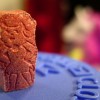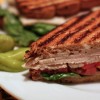 Vitamin D is needed for normal absorption of calcium and phosphorus. It helps put these minerals into bones and teeth. This makes bones stronger and reduces risk for bone fractures. Vitamin D also helps keep the immune system functioning normally, so our bodies can resist some types of disease. This 2-page fact sheet was written by Linda B. Bobroff and Isabel Valentín-Oquendo, and published by the UF Department of Family Youth and Community Sciences, February 2014.
Vitamin D is needed for normal absorption of calcium and phosphorus. It helps put these minerals into bones and teeth. This makes bones stronger and reduces risk for bone fractures. Vitamin D also helps keep the immune system functioning normally, so our bodies can resist some types of disease. This 2-page fact sheet was written by Linda B. Bobroff and Isabel Valentín-Oquendo, and published by the UF Department of Family Youth and Community Sciences, February 2014.
http://edis.ifas.ufl.edu/fy207
Tag: Vitamins
Facts About Vitamin B6
 Vitamin B6, also called pyridoxine, is a water-soluble vitamin needed to break down the protein we eat. This vitamin is used by our bodies to make important proteins, and it helps our muscles use energy. It also helps make brain chemicals that tell the systems in our bodies what to do. This 2-page fact sheet was written by Anne Kendall, and published by the UF Department of Family Youth and Community Sciences, July 2013.
Vitamin B6, also called pyridoxine, is a water-soluble vitamin needed to break down the protein we eat. This vitamin is used by our bodies to make important proteins, and it helps our muscles use energy. It also helps make brain chemicals that tell the systems in our bodies what to do. This 2-page fact sheet was written by Anne Kendall, and published by the UF Department of Family Youth and Community Sciences, July 2013.
http://edis.ifas.ufl.edu/fy213
Datos sobre las vitaminas (FCS8808S/FY1343)
 Las vitaminas son compuestos químicos que el cuerpo utiliza de muchas maneras. Nosotros necesitamos obtener las vitaminas en nuestra dieta porque nuestros cuerpos no las pueden crear. Existen 13 tipos de vitaminas que han sido identificadas como nutrientes importantes para los humanos. This 3-page fact sheet was written by R. Elaine Turner and Wendy J. Dahl, and published by the UF Department of Family Youth and Community Sciences, November 2012.
Las vitaminas son compuestos químicos que el cuerpo utiliza de muchas maneras. Nosotros necesitamos obtener las vitaminas en nuestra dieta porque nuestros cuerpos no las pueden crear. Existen 13 tipos de vitaminas que han sido identificadas como nutrientes importantes para los humanos. This 3-page fact sheet was written by R. Elaine Turner and Wendy J. Dahl, and published by the UF Department of Family Youth and Community Sciences, November 2012.
http://edis.ifas.ufl.edu/fy1343
Datos sobre la niacina (FCS8669S/FY1340)
 La niacina es una de las vitaminas del grupo B (vitamina B3). Nuestro cuerpo necesita la niacina para usar los carbohidratos, las grasas y las proteínas. La niacina también se necesita para reparar el ADN y para el uso normal del calcio en el cuerpo. This 2-page fact sheet was written by R. Elaine Turner y Wendy J. Dahl, and published by the UF Department of Family Youth and Community Sciences, November 2012.
La niacina es una de las vitaminas del grupo B (vitamina B3). Nuestro cuerpo necesita la niacina para usar los carbohidratos, las grasas y las proteínas. La niacina también se necesita para reparar el ADN y para el uso normal del calcio en el cuerpo. This 2-page fact sheet was written by R. Elaine Turner y Wendy J. Dahl, and published by the UF Department of Family Youth and Community Sciences, November 2012.
http://edis.ifas.ufl.edu/fy1340
Facts about Niacin (FCS8669/FY212)
 Niacin is one of the B vitamins (vitamin B3). Our bodies need niacin to use the energy in carbohydrates, fats, and proteins. Niacin also is needed for DNA repair and for the normal use of calcium in the body. This 2-page fact sheet was written by R. Elaine Turner and Wendy J. Dahl, and published by the UF Department of Family Youth and Community Sciences, November 2012.
Niacin is one of the B vitamins (vitamin B3). Our bodies need niacin to use the energy in carbohydrates, fats, and proteins. Niacin also is needed for DNA repair and for the normal use of calcium in the body. This 2-page fact sheet was written by R. Elaine Turner and Wendy J. Dahl, and published by the UF Department of Family Youth and Community Sciences, November 2012.
http://edis.ifas.ufl.edu/fy212
Datos sobre la riboflavina (FCS8668S/FY1344)
 La riboflavina es una de las vitaminas del grupo B. También es conocida como la vitamina B2. Nosotros necesitamos la riboflavina para utilizar los carbohidratos, grasas y proteínas en los alimentos que comemos. La riboflavina ayuda a utilizar estos nutrientes en energía para el cuerpo y para funciones como antioxidante. La riboflavina también se necesita para utilizar correctamente las vitaminas niacina, el ácido fólico y la vitamina B6. This 2-page fact sheet was written by R. Elaine Turner y Wendy J. Dahl, and published by the UF Department of Family Youth and Community Sciences, November 2012.
La riboflavina es una de las vitaminas del grupo B. También es conocida como la vitamina B2. Nosotros necesitamos la riboflavina para utilizar los carbohidratos, grasas y proteínas en los alimentos que comemos. La riboflavina ayuda a utilizar estos nutrientes en energía para el cuerpo y para funciones como antioxidante. La riboflavina también se necesita para utilizar correctamente las vitaminas niacina, el ácido fólico y la vitamina B6. This 2-page fact sheet was written by R. Elaine Turner y Wendy J. Dahl, and published by the UF Department of Family Youth and Community Sciences, November 2012.
http://edis.ifas.ufl.edu/fy1344
Datos sobre la Tiamina (FCS8667S/FY1342)
 La tiamina es una de las vitaminas del grupo B. Es también llamada B1. Nosotros necesitamos tiamina para utilizar los carbohidratos que comemos. La tiamina ayuda a transformar los carbohidratos en energía para el cuerpo. El cuerpo también necesita tiamina para usar algunos de los aminoácidos que componen las proteínas. This 2-page fact sheet was written by R. Elaine Turner y Wendy J. Dahl, and published by the UF Department of Family Youth and Community Sciences, November 2012.
La tiamina es una de las vitaminas del grupo B. Es también llamada B1. Nosotros necesitamos tiamina para utilizar los carbohidratos que comemos. La tiamina ayuda a transformar los carbohidratos en energía para el cuerpo. El cuerpo también necesita tiamina para usar algunos de los aminoácidos que componen las proteínas. This 2-page fact sheet was written by R. Elaine Turner y Wendy J. Dahl, and published by the UF Department of Family Youth and Community Sciences, November 2012.
http://edis.ifas.ufl.edu/fy1342
Facts about Vitamins (FCS8808/FY890)
 Vitamins are chemical compounds that the body uses in a variety of ways. We need to get vitamins from our diet because we can’t make them in the body. There are 13 different vitamins that have been identified as important nutrients for humans. Learn more in this 3-page fact sheet written by R. Elaine Turner and Wendy J. Dahl, and published by the UF Department of Family Youth and Community Sciences, April 2012.
Vitamins are chemical compounds that the body uses in a variety of ways. We need to get vitamins from our diet because we can’t make them in the body. There are 13 different vitamins that have been identified as important nutrients for humans. Learn more in this 3-page fact sheet written by R. Elaine Turner and Wendy J. Dahl, and published by the UF Department of Family Youth and Community Sciences, April 2012.
http://edis.ifas.ufl.edu/fy890
Facts About Thiamin (FCS8667/FY210)
 A lack of thiamin causes the disease beriberi. People with beriberi have difficulty standing, walking and controlling their muscles. It’s very easy to get enough thiamin in the diet because it’s added to many processed grains. However, people who abuse alcohol or have a very poor diet may suffer from a thiamin deficiency. This 2-page fact sheet was written by R. Elaine Turner and Wendy J. Dahl, and published by the UF Department of Family Youth and Community Sciences, April 2012.
A lack of thiamin causes the disease beriberi. People with beriberi have difficulty standing, walking and controlling their muscles. It’s very easy to get enough thiamin in the diet because it’s added to many processed grains. However, people who abuse alcohol or have a very poor diet may suffer from a thiamin deficiency. This 2-page fact sheet was written by R. Elaine Turner and Wendy J. Dahl, and published by the UF Department of Family Youth and Community Sciences, April 2012.
http://edis.ifas.ufl.edu/fy210
Facts About Riboflavin (FCS8668/FY211)
 Did you know that mushrooms are a good source of riboflavin? Riboflavin is one of the B vitamins, also is known as vitamin B2. We need riboflavin to use the carbohydrates, fats, and proteins in the foods we eat. Riboflavin helps us use these nutrients for energy in our bodies and additionally functions as an antioxidant. Riboflavin also is needed to properly use the vitamins niacin, folate, and vitamin B6. For more facts about riboflavin, check out this 2-page fact sheet written by R. Elaine Turner and Wendy J. Dahl, and published by the UF Department of Family Youth and Community Sciences, April 2012.
Did you know that mushrooms are a good source of riboflavin? Riboflavin is one of the B vitamins, also is known as vitamin B2. We need riboflavin to use the carbohydrates, fats, and proteins in the foods we eat. Riboflavin helps us use these nutrients for energy in our bodies and additionally functions as an antioxidant. Riboflavin also is needed to properly use the vitamins niacin, folate, and vitamin B6. For more facts about riboflavin, check out this 2-page fact sheet written by R. Elaine Turner and Wendy J. Dahl, and published by the UF Department of Family Youth and Community Sciences, April 2012.
http://edis.ifas.ufl.edu/fy211
Los hechos acerca de la vitamina K (FCS8666Span/FY940)
 La vitamina K ayuda al cuerpo a hacer las proteínas que se necesitan para la coagulación normal de la sangre. La vitamina K también se necesita para hacer importantes proteínas para los huesos. This 2-page fact sheet is the Spanish language version of Facts about Vitamin K. Written by R. Elaine Turner and Wendy J. Dahl and published by the UF Department of Family Youth and Community Sciences, October 2011.
La vitamina K ayuda al cuerpo a hacer las proteínas que se necesitan para la coagulación normal de la sangre. La vitamina K también se necesita para hacer importantes proteínas para los huesos. This 2-page fact sheet is the Spanish language version of Facts about Vitamin K. Written by R. Elaine Turner and Wendy J. Dahl and published by the UF Department of Family Youth and Community Sciences, October 2011.
http://edis.ifas.ufl.edu/fy940
De compras para la salud: La vitamina D (FSHN1102S/FS175)
Vitamin D needs can be met by eating foods containing Vitamin D and taking vitamin supplements, but few foods are consistent in their levels of vitamin D. This 7-page Spanish language fact sheet will help you be an informed shopper and find brands that meet your vitamin D needs. Written by Lauren Foster and Wendy J. Dahl, and published by the UF Department of Food Science and Human Nutrition, May 2011.
http://edis.ifas.ufl.edu/fs175
Shopping for Health: Vitamin D (FSHN1102/FS163)
Vitamin D needs can be met by eating foods containing Vitamin D and taking vitamin supplements, but few foods are consistent in their levels of vitamin D. This 6-page fact sheet will help you be an informed shopper and find brands that meet your vitamin D needs. Written by Lauren Foster and Wendy J. Dahl, and published by the UF Department of Food Science and Human Nutrition, May 2011.
http://edis.ifas.ufl.edu/fs163
Facts about Vitamin C (FCS8702/FY215)
Vitamin C, also known as ascorbic acid, has a wide variety of uses in the body. It helps slow down or prevent cell damage. It is needed to maintain healthy body tissues and the immune system. Vitamin C also helps our bodies absorb iron from plant foods. Learn the facts about this important vitamin with this 2-page fact sheet written by Linda B. Bobroff and Isabel Valentín-Oquendo and published by the UF Department of Family Youth and Community Sciences, December 2010.
http://edis.ifas.ufl.edu/fy215
Carotenoids and Eye Health (FCS8935/FY1217)
Eating a diet rich in colorful fruits and vegetables provides a variety of nutrients as well as phytochemicals that can promote health. Lutein and zeaxanthin are two non-provitamin A carotenoids that appear to be protective against age-related macular degeneration (AMD), the leading cause of blindness in older adults. This 2-page fact sheet was written by Linda B. Bobroff, and published by the UF Department of Family Youth and Community Sciences, March 2011.
http://edis.ifas.ufl.edu/fy1217
FCS8640/FY207 Facts about Vitamin D
Revised! FCS8640, a 2-page illustrated fact sheet by Linda B. Bobroff and Isabel Valentín-Oquendo, summarizes key facts about vitamin D’s role in human nutrition — why we need it, what happens if we don’t get enough, how much we need, how we can get enough, supplements, and how much is too much. Includes links to reliable nutrition information on the Web. Published by the UF Department of Family Youth and Community Sciences, December 2010.
http://edis.ifas.ufl.edu/FY207
FCS8666/FY209 Facts about Vitamin K
Revised! FCS8666, a 3-page fact sheet by R. Elaine Turner and Wendy J. Dahl, answers common questions about this vitamin found mostly in green vegetables that is needed to make proteins for normal blood clotting. Includes references. Published by the UF Department of Family, Youth, and Community Sciences, October 2010.
http://edis.ifas.ufl.edu/fy209
FCS8669/FY212 Facts about Niacin
Revised! FCS8869, a 2-page illustrated fact sheet by R. Elaine Turner and Wendy J. Dahl, answers questions about this B vitamin. Includes references. Published by the UF Department of Family Youth and Community Sciences, May 2010.
http://edis.ifas.ufl.edu/fy212
FCS8639/FY206 Facts about Vitamin A
Revised! FCS8639, a 2-page fact sheet by Nan C. Jensen and Linda B. Bobroff, answers questions about this fat soluble vitamin that is essential to our health. Published by the UF Department of Family Youth and Community Sciences, December 2009.
http://edis.ifas.ufl.edu/fy206
FCS8705/FY218 Facts about Zinc
Revised! FCS-8705, a 2-page fact sheet by Linda B. Bobroff, uses a question and answer format to informs clients about this mineral for human nutrition. Published by the UF Department of Family Youth and Community Sciences, June 2009.
http://edis.ifas.ufl.edu/FY218